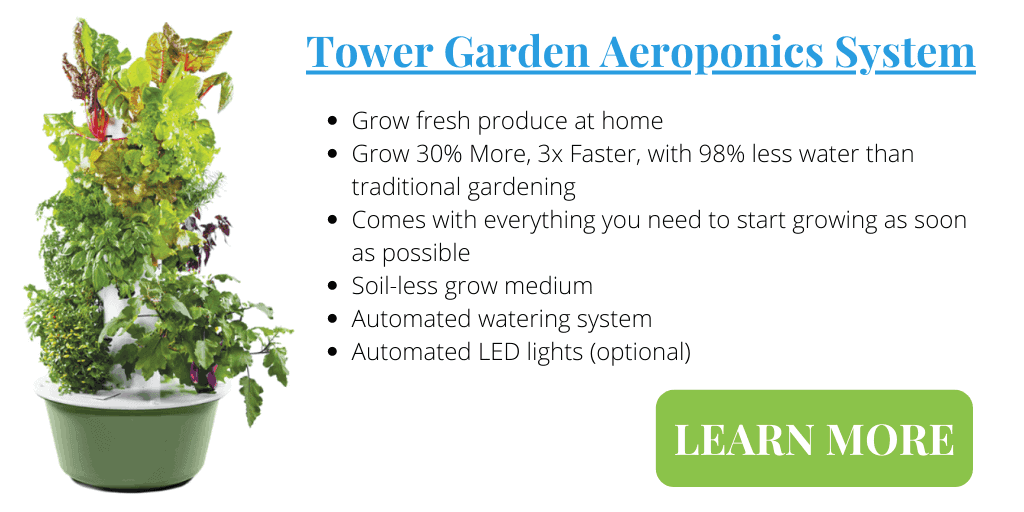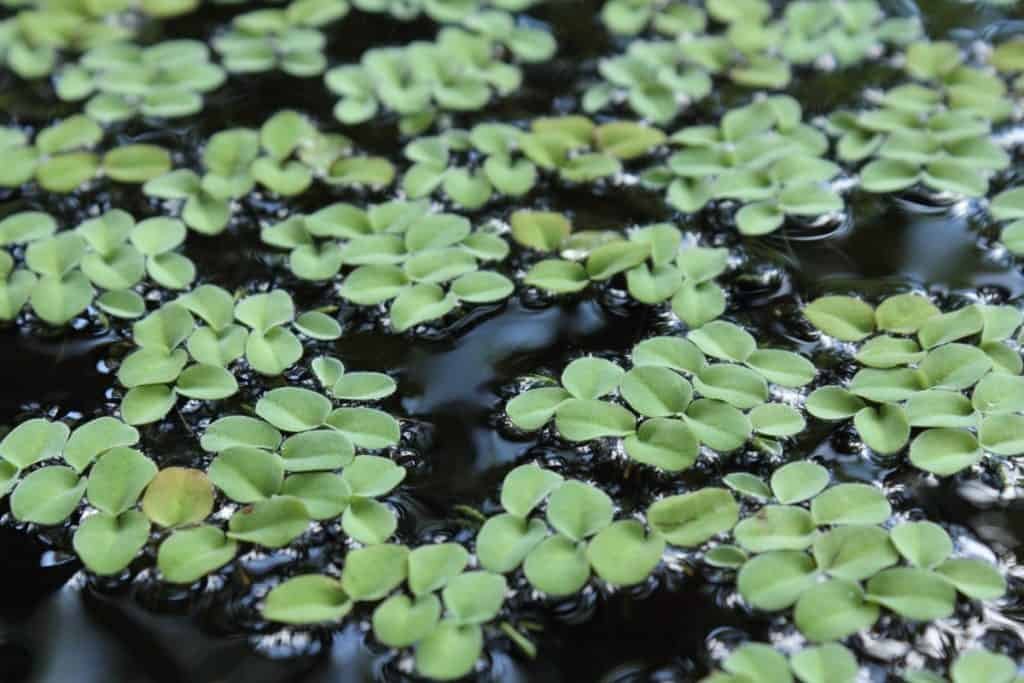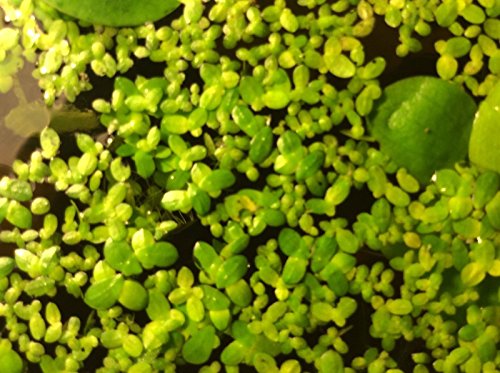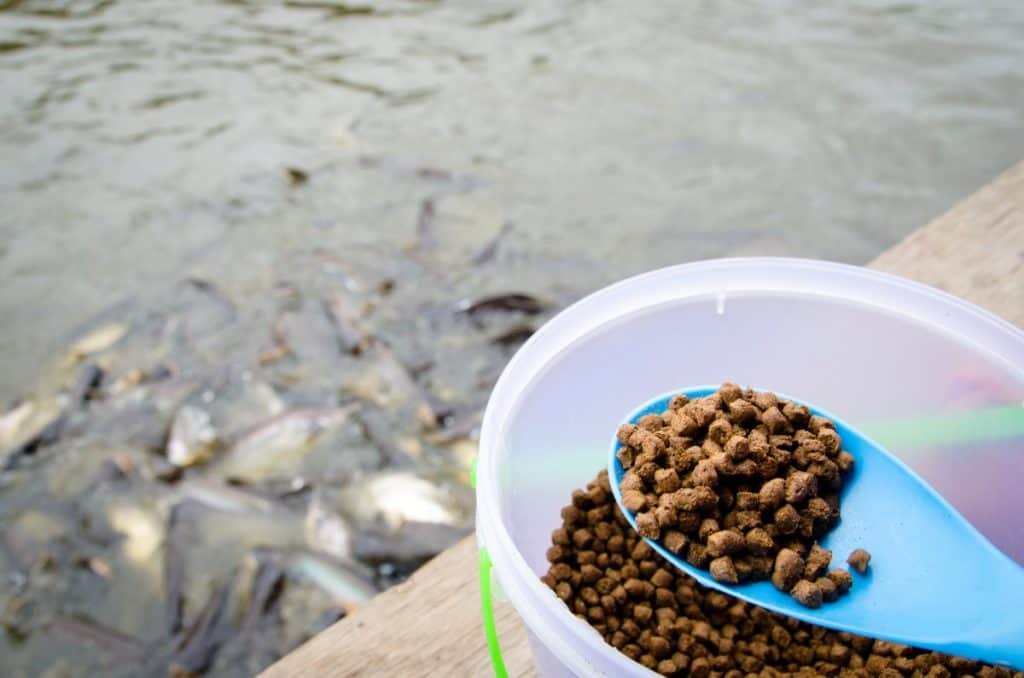Fish Feed to Nutrient Conversion Efficiency of Aquaponics
Aquaponic systems are a great way to grow plants and raise fish in a symbiotic environment. But feeding your fish in aquaponics can be a challenge at first, especially when you are not sure if you are meeting their dietary requirements.
Fortified fish pellets are the most common food choice for an aquaponic system due to the ease of use and complete nutritional profile. However, there are many alternative food sources that do not contain fishmeal and have proper concentrations of protein, such as duckweed, soy meal, and soldier fly larvae.
Feeding your fish the best food in the appropriate amounts will make running an aquaponic system much easier in the long run and keep the ecosystem in balance.
Typically Aquaponics is a combination of aquaculture, the raising of fish, and hydroponics, the growing of plants in water, but you can also use aeroponics to grow your plants. Learn more about how aquaponics works in my article, What is Aquaponics – A Complete Guide.
My favorite form of aeroponics is the Tower Garden. It's a simple closed loop system that reduces water usage by over 90% and can grow 20+ plants in a 3′ x 3′ space. Check out What is a Tower Garden and How Does it Work? for more details.

What Do Aquaponics Fish Eat?
What you feed your fish in your aquaponic system will depend on the type of fish you are raising. Different fish have different dietary needs, some prefer insects while others prefer plants.
Tilapia is the most popular choice for aquaponics gardens because they are easy to feed and are good to eat. Several other fish species are used for these purposes, but it can be more challenging to provide food due to their protein requirements.
The table below lists some of the species of fish that are best-suited for aquaponic systems and what they prefer to eat:
| Species of Fish | What They Eat | Protein Requirement |
| Bass | Pellets/flakes, Smaller fish | 45% (small mouth) 40% (large mouth) |
| Carp | Aquatic plants, insects, pellets/flakes | 30-35% |
| Channel Catfish | Pellets/flakes | 25-55% (depends on age and size) |
| Goldfish | Aquatic plants, insects, pellets/flakes | 30-40% (adults) |
| Perch | Insects, pellets/flakes, vegetables | 36% |
| Rainbow Trout | Pellets/flakes, smaller fish | 37-41% |
| Tilapia | Aquatic plants, pellets/flakes, vegetables | 28-30% |
Nearly every single one of the listed fish species will eat some variation of fish pellets. Some species, like largemouth bass, would prefer to eat smaller fish, while others, like the Tilapia, are herbivores and would rather eat plants.
You should mix up your fishes' diet as much as you can, provided that you are following their nutritional guidelines for optimal growth. Several alternative food sources can provide a good supply of the proteins, carbohydrates, and fats that fortified pellets typically offer.
Pellets
Pellets are the most common type of food used in aquaponics; this is because they pack a massive nutritional punch in a small package. They have been specifically engineered to deliver the nutrients recommended by researchers.
There are sinking pellets and floating pellets available. Floating feeds are preferred by some owners, simply because the floating meals offer a better look into how much food the fish are consuming. If the fish are not eating, this could be a sign of stress.
Most fish pellets contain fishmeal which is made from the left over fish not used for human consumption, like the bones. There is some controversy around fish meal and it's environmental impact. Some manufacturers are starting to include alternate sources of protein other than fishmeal in their pellets.
While pellets are the easiest way to feed fish but it's not the most natural way.
Rangen Fish Food
Rangen is one of the major manufacturers of fish food used in the aquaponics industry. Rangen is a fish food of choice amongst many aquaponics farmers, due in large part to the insect and fish meal base.
These ingredients add up to a feed mixture that has a high concentration of protein at 45%. The University Of Florida recommends that protein makes up 32-45% of the total nutrients in fish food but the protein requirements will vary depending on the fish species.
Rangen fish food pellets come in a couple of different sizes:
- 3/16" pellets (Amazon Link)
- ⅛" pellets (Amazon Link)
As far as pellet sizes go, there are no specific guidelines. However, fish pellets should be small enough to be consumed by fish that are as little as 2 inches long. When the fish are smaller, you may have to mash the pellets up.
Insects
You may not necessarily want to feed your fish pellets all the time. As I mentioned a lot of pellet foods contain fishmeal, which can have a significant ecological impact if they are used as the sole food source. Complementing your fishes' diet with insects is one way to add a more natural component.
Fish species commonly used in aquaponics that enjoy insects can include perch, goldfish, and carp. Bass will also consume insects, as they are opportunistic feeders. Insects, worms, and black soldier fly larvae are suggested as alternatives to pellets.
Soldier Flies
Soldier flies are a popular choice because they can reproduce and mature rapidly. With such a fast growth cycle, it's not difficult to use these as a sustainable food source. This insect is also a good source of protein.
An added benefit of soldier flies is that they are simple to raise:
- Will eat table scraps and other waste.
- Need to be raised in a warm and humid environment.
- Don't like excessively dry or wet conditions.
- Don't like direct sunlight.
Black soldier flies are easy to find online and affordable too. You can actually buy live black soldier fly larvae from Amazon. Once you have your larvae all you need to raise them is a "grub tub"
You can build the tub yourself or purchase one. The DIY version will consist of a large tote tub, a 5 gallon bucket, some PVC pipe, and using the instructions shown in this guide.
Vegetables/Plants
Omnivores, like Tilapia and Carp, will eat vegetables like lettuce and peas that are leftover from the garden. The challenge with using plants as a sole food source for fish, however, is meeting the dietary needs for protein, carbohydrates, and fats. The best plant-based proteins come from soy meal, cornmeal, and wheat.
It may be easiest for you to combine a partial pellet-based diet and plant-based diet rather than relying on a single food source. Duckweed is an excellent sustainable and organic food source. It can be grown on-site quite easily and can contain up to 43% protein when grown under optimal conditions.

Duckweed
Duckweed is one of the recommended alternative foods, especially for Tilapia. It can be grown organically in the fish pond itself. With proper care, you can cut down on the amount of processed fish food that you need to use.
Duckweed is simple to grow and serves a vital role in recycling nutrients within the aquaponics system. It can be very high in protein, containing up to 43%, when grown in the right conditions making it an excellent alternative to traditional food pellets.
Duckweed will grow extraordinarily fast and can easily grow out of control. It can double in size within 2 days so you will only need to start with a handful or two of duckweed starter plants. Your duckweed supply can be harvested twice per week.
Duckweed that is grown in nutrient-poor water only contains 15-25% protein, making it much less useful as a fish food when you consider the fact that fish pellets are usually tailor-made to have protein concentrations in the range of 40-45%.
To grow duckweed, keep these tips in mind:
- The water should be at least 8 inches deep.
- Keep the water temperature between 50-90 degrees Fahrenheit
- Planting is very easy; you only need to add a small amount of duckweed to the tank.
- The duckweed can be harvested and stored frozen until it is time to feed the fish.
- pH should be kept between 6.0-7.5

Small Fish
Some fish, like Bass and Trout, are carnivorous and prefer to eat other fish. This can make them difficult to pellet train and are not commonly used in aquaponics. Bass may even resort to eating other Bass in the tank before they start to eat pellets.
You may need to feed them with minnows or other baitfish species, but keeping these baitfish alive is a challenge in and of itself and can be costly.
What Should I Feed My Aquaponics Fish?
Food selection depends on which species you are trying to raise in your aquaponics garden. Generally speaking, fish food should consist of the following nutrient breakdown:
- 32-45% proteins
- 4-24% fats
- 10-30% carbohydrates
- 1-2.5% minerals
- 1-2.5% vitamins
However, some fish require more protein than others. Tilapia, for example, require a good source of food that contains 28-30% protein, while trout require 37-41% protein.
Fish that eat more plants will require less protein as part of their daily diet than fish that eat insects or other animals; this is why trout need more protein than Tilapia. It is also why Tilapia are favored over species like Trout and Bass that can be much more challenging to raise in an aquaponics garden.

Alternative Ingredients to Look for in Fish Food
If feeding your fish pellets appeals to you but you don't want your fish food to contain fishmeal there are alternative protein sources available.
The following ingredients are beginning to gain more and more traction as an alternative protein source in fish food:
- Soybeans
- Barley
- Rice
- Peas
- Canola
- Lupine
- Corn or Wheat Gluten
According to the Aquaponics Journal, a few of these show particular promise as alternatives to the traditional pellet feeds that contain fishmeal. Soybeans have a high concentration of protein. Barley and beer have also been explored as viable sources of protein.
How Much Food Should I Give to My Aquaponics Fish?
Feeding the fish in your aquaponics garden is a balancing act. Overfeeding your fish can lead to excess waste from uneaten food. Excess waste can cause an imbalance in your system leading to unwanted smells (read more in my article Do Aquaponics Smell?) or a disruption in the oxygen-carbon dioxide cycle of the pond.
Of course, feeding your fish too little can cause other issues even lead to your fish eating each other.
Fish should be fed 1.5-2% of their body weight each day. This should be accomplished via 2-3 separate feedings each day. These should be spaced out evenly, as to avoid the problem of overfeeding the fish or having excess food accumulate in the tank.
You shouldn't feed your fish more than they can eat in 5-10 minutes. This will reduce the excess food waste in your system that can upset the balance.
Why You Monitor Your Fish's Feeding Habits
Your fish's environment will affect how much they will eat. If the water is too hot or cold, the pH is off or the fish are stressed they will not eat.
By monitoring your fish's eating habits you can quickly find out if there is something wrong with your aquaponics system.
When you first start up your aquaponic system you should be testing the water chemistry every day; feeding times would be an excellent opportunity to test the water.
The most important things to check in a freshwater system are:
- Water Temperature
- Dissolved Oxygen (DO)
- pH (acidity/alkalinity)
- Ammonia levels
- Nitrite levels
- Nitrate levels
You can find home test kits online that will cover all the bases. One example of such a test kit is the API Freshwater Master Test Kit. This test kit measures pH, ammonia, nitrite, and nitrate. It is simple to use, as testing the water simply involves placing a paper strip into the tank. The test strip changes colors based on the value for a specific parameter.
If you want to measure dissolved oxygen, then you will need to get a sensor or titration kit. The CHEMetrics Dissolved Oxygen Kit is simple and straightforward to use. You drop an indicator in a tube of collected water and watch for a color change that corresponds to the concentration of dissolved oxygen.
The test results you get will help you determine how you should proceed with feeding patterns for your fish. For example, if the concentration of ammonia in the tank spikes, then you should take that as a sign to reduce the amount of fish food that you are introducing to the tank.
Final Thoughts
What you feed the fish in your aquaponic system will depend on the type of fish you are raising. Getting the proper nutritional content for different species is important for a successful system.
Fish pellets are one of the simplest ways to feed your fish. Other alternatives and more natural options include soldier fly larvae and duckweed. Soldier fly larvae is the easiest insect to raise for fish food. Duckweed is a great source of protein and grows very easily.
Once have the right type and amount of food, you will find that feeding fish in an aquaponics system is not too much of a challenge.
Source: https://smallscalegardener.com/feeding-fish-aquaponics/
0 Response to "Fish Feed to Nutrient Conversion Efficiency of Aquaponics"
Post a Comment